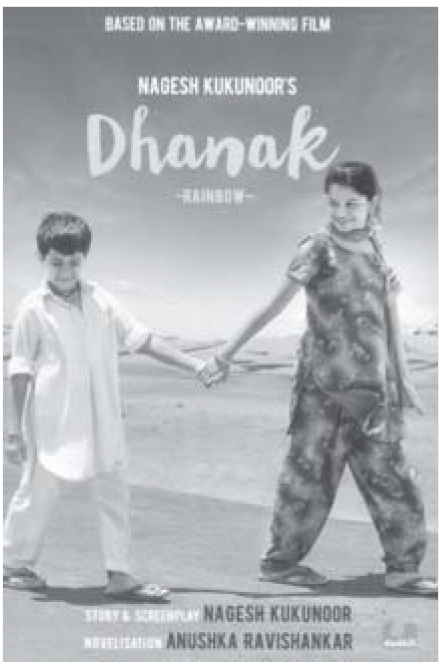The charmingly titled Dhanak follows a time honoured tradition of a journey story. What is different about it is that it is also travelling through different media like a hot knife shot through butter. I haven’t seen the film, but after Anushka Ravishankar’s seamless novelization (a fine new coinage), I feel like I have. Anushka introduces the two lovable heroes, Pari and Chotu with swift ease. The piece of jaggery that a sightless Chotu catches unerringly, their walk to school that is the very first journey, reveals the family situation and their bond with an efficient economy of words. Shahrukh Khan also makes an entry in this early and we know that he is going to drive the action in some unexpected way. And you are hooked because it promises to be deliciously improbable but also really entertaining, like good cinema should be. From Homer to Chaucer, journeys are a great way to bring in new and interesting characters into the universe of the protagonists. Each character brings the possibility of introducing new foibles, strange but probable situations that stretch you almost to breaking point, but stop short of breaking the illusion of reality. The two young siblings, Pari and Chotu have a very compelling reason to keep going in spite of all the troubles that are presented with a light touch. After Pari’s education is interrupted by a seemingly heartless Chachi and a good for nothing Chacha, it is only a matter of time before the two set out to keep a promise that Pari has made to Chotu. And Shahrukh Khan, no less, is going to help her to do that. As they set out towards Jaisalmer where Shahrukh is shooting a film, a kind truck driver helps them but he also warns them about the dangers of being out on the road alone. The scene moves abruptly to a fat Indian wedding where there are festivities and quantities of jalebi and ghewar and Chotu of the insatiable appetite thinks he has come to heaven. Next we have a touch of local colour with their stop at Shira Mata’s temple where there is a Baba and a real live goddess who actually knew Shahrukh Khan! Hmm…of all the odds…After another chocolatey encounter with a guitar playing eccentric white man, it was time for some hard lessons. A Kalbeliya dancer with a pistol tucked into her skirt is an improbable avatar for Robin Hood, but fits in very nicely in the desert landscape dotted with laddoos, shira and spiked rasgollas. Throw in a soothsayer Dadisa and you want to turn the pages quickly to see if Pari and Chotu will make it to their final destination. And the clock is ticking away relentlessly and there are only two days left for Pari to make good her promise to Chotu, and you dear reader are gripping the armrest of your seat. Will they make it to Jaisalmer in time to meet Shahrukh Khan? Who will help them when their faith is sorely tested? In the dreamlike landscape of the merciless sand dunes, who helps Pari keep her promise? It would be unfair to give away any more information. Suffice it to say that the wheel of time turns full circle and not everything can be explained. Not everything should be explained . There are charming spaces for speculating, for drawing up your own word pictures, supplying your own witticisms in the conversations between the siblings. The photographs from the film are a perfect foil to the text. They help you dip into the colour and drama of the landscape and the array of strange and odd characters. They will lead many a reader to the screen because you want to see more. Anushka Ravishankar’s novel creates believable characters. Chotu’s blindness is never overplayed into sentimentality even though it is a prime driver of the action. The improbability of the plot is made an advantage as the two children romp along quite merrily letting their lessons learnt sit gently on their shoulders. There is a pervasive spirit of optimism that leaves the reader smiling even during dire moments. The manner in which cinematic references are woven into the novel, they feel entirely natural. Screen heroes are magical and yet close to our heartbeats as they recast the cultural references of our country in a manner that unites us all. The cinematic and visual unfolding of the action is reassuring because we have ‘seen’ it before in films. The tone of the narration is a mixture of irreverence and empathy. This is a cross-media experiment in storytelling that hits bull’s eye. Both the novel and the film are surely enriched by each other. Read the novel. Watch the film.
November 2016, volume 40, No 11

